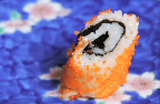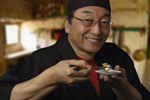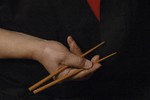
Photo: Courtesy of the Chiune Sugihara Museum; Kaunas, Lithuania
Last night, I once again pulled out one of the gems of my movie archives: “Schindler’s List” (1993). This is one of those films that I love, but I really have to be in the right mood for, as I spend most of it in tears. Part of the tears are from being so disappointed with the hate that humanity can have towards his fellow-man; part is from the bravery that individuals can have within the clutches of such hate; and part is for the admiration that one person (if they can find the strength to actually go against the “norm”) can have on the world. So, at the end of the film, Oskar Schindler has saved 1.100 Jews and is honored as one of the “Righteous Among the Nations” in Israel. I think it is the power of the story and Mr. Spielberg’s film that after, I asked myself, “OK, so who else is honored?” Usually, questions like these lead to research, and this particular research lead to yet another one of history’s forgotten heroes of this period.
Kaunas, Lithuania, shortly before Chanukah 1939
Solly Ganor is an 11-year-old jewish boy living in Kaunas. His parents had emigrated from Russia years before, from the Russian revolution. His family is fairly well off from their business of textile import/export, but Solly, concerned about Jewish refugees streaming in from Poland, (which has been recently invaded by the Nazis) has given away all his allowance to the refugee boards to help. Solly goes to his aunt’s gourmet food shop to borrow some money for a film. In the shop, talking to his aunt, a stranger overhears his plight and kindly offers the money to Solly. The well-dressed gentleman has been in the shop to pick up a few items for dinner. Solly is struck by three things, the man’s generosity, his kind eyes, and that he is clearly from another place than Kaunas. The man is in fact, Japanese Vice-Counsel Chiune Sugihara. To return the favor, Solly invites the Vice-Counsel and his wife to celebrate Chanukah with his family. Years later, Chiune and his wife Yukiko remember the festival of lights spent with the Ganor family: the songs, the ceremony, the cakes, the stories, the fun. Far from home and their own family, the easy welcome of a sweet boy and the Jewish family makes an impact on the Japanese couple.
Later, after the Nazis invade Lithuania, the Ganor family was sent to Dachau, and sadly only Solly and his father survived. Ironically, it is the Japanese-Americans of the 522nd Field Artillery Battalion, men who have been interred by their own country who free the two Ganors from Dachau. To this day, Solly Ganor cannot look upon a Japanese man without experiencing feelings of affection, friendship, and gratitude.
The Dutch Connection:
A half year after the Chanukah with the Ganor family, on June 15, 1940, the Nazis invade Lithuania and now the combined Polish immigrants plus Lithuania’s own Jews are in danger. Russia orders all foreign ambassadors to leave Lithuania. Only Dutch counsel Jan Zwartendijk and Vice-Counsel Chiune stay as they hatch a plan together to try to save the Jews of both Poland and Lithuania: two Dutch colonies, Curacao and Dutch Guiana (now Suriname) do not need entrance visas. The only way out is to the east, through Russia, via the trans-Siberian railway. The Russians will allow the Jews through their country, but not to stay. The Jews need a destination before they can go to the Dutch islands. Japan is the answer.
An Outright Refusal Followed by an Outright Insubordination:
Vice-Counsel Sugihara asks for and is denied leniency for the Jews three times by his native Japan. Tokyo’s Foreign Ministry states in no uncertain terms that the visas to Japan must not be issued. Risking his career and his future and chancing imprisonment (or worse) for not only himself, his wife, and his family, Sugihara, for the next month, tirelessly issues thousands of visas for Europe’s Jews. Often, he works 18-20 hour days, rarely eating, pausing only to have his wife massage his aching fingers, tired from signing visas. He is even signing visas on the way to the rail station, as he is forced to leave, and passing them out the car window to people. At the end he has signed blank sheets of papers and gives these, with his seal of office, to an assistant. Before he leaves, he bows deeply to the crowd and apologizes for not having done more. In the end, Vice-Counsel Chiune Sugihara has saved in excess of 6000 Jews!
Obscurity and a Final Tribute:
As a valuable diplomat and translator, Japan used Sugihara’s services until the end of the war, but then, summarily dismissed him. Sugihara worked as a part-time translator and even struggled for a while selling light bulbs door-to-door. The final decades of his life he worked as a manager of an export company that had dealing with Moscow. He never mentioned his dealings in Lithuania and his friends and neighbors never knew of him as an extraordinary man. It was not until 1969 when a man that was saved by Sugihara, hunted him down to thank him, and together with hundreds of other Jews that were saved by him, persuaded Israel to give Sugihara (like Schindler) the honor of “Righteous of the Nations” in 1985. Sugihara passed away the following year. It was only when a huge delegation of Jews, from around the world, showed up at Sugihara’s funeral that his friends and neighbors had any idea of his contribution to mankind.
Before his death, and forty-five years after his actions in Lithuania, he was asked the eternal question, “Why?” To this, he replied his simple devotion, “They were human beings and they needed help.”
 My friend Pamela gave a slew of fresh veggies last week, from her CSA. All have been very delicious, but the most interesting was four daikon radish. Daikon is a larger (generally about 6″-1′ long by about 2-3″ circumference) white variety of the radish family, originally from Japan. It is not nearly as hot as the American red variety of radish, but is mild, juicy, and with just a tiny bit of hot and sweetness combined. Daikon is full of vitamin C, and is good for digestion. It is delicious as an accompaniment to just about any Japanese meal or as a healthy snack.
My friend Pamela gave a slew of fresh veggies last week, from her CSA. All have been very delicious, but the most interesting was four daikon radish. Daikon is a larger (generally about 6″-1′ long by about 2-3″ circumference) white variety of the radish family, originally from Japan. It is not nearly as hot as the American red variety of radish, but is mild, juicy, and with just a tiny bit of hot and sweetness combined. Daikon is full of vitamin C, and is good for digestion. It is delicious as an accompaniment to just about any Japanese meal or as a healthy snack.

































